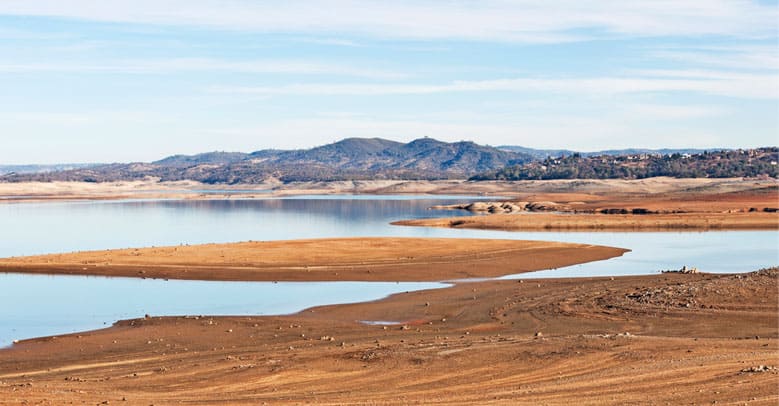All Dried Up:
January 28, 2015

Folsom Lake in Folsom, California.
California is just shaking off the dust from a lengthy, and costly, 3-year drought. While a recent National Oceanic and Atmospheric Administration’s study cites natural atmospheric cycles as the main culprit behind California’s drought, there is plenty of evidence that climate change is already putting new pressures on this thirsty region. What we do know for sure is that rising temperatures are leading to reduced snowfall— the environmental savings account that irrigates the west coast come spring— and causing earlier melts, flooding out rivers and then drying up prematurely.
Meanwhile, underground water reserves across the U.S. have dropped by 53 million acre-feet since 2003, about twice the volume of Lake Mead, according to the New York Times. Drastic down swings like this point to serious, and systemic, mismanagement. If you take a closer look, our regulatory and economic understanding of how to sustainably use this most basic resource are historically murky.
With no comprehensive federal regulation, the cost of water varies wildly from city to city— a spectrum of pricing out of proportion to how much actual rain the region gets. For example, yearly water costs for a family using 400 gallons a day in Fresno, where less than 11 inches falls a year, is $28.26. The same family using the same amount of water in Boston, where the rainfall is over 40 inches, would spend $77.73.
The situation only gets more complex on farms, which account for 80% of water usage nationally. No federal rules on water management apply, with each state enforcing different laws on water usage. Water pricing is even more skewed out west by antiquated rules where the first farmer to draw water gets the rights. Unsustainable usage is actually incentivized in these rules, which dictate that if the first farmer doesn’t use up all the water, it goes to “junior” users waiting in line for it. Of course, actual usage is part of the issue too. Of approximately 60 million acres of irrigated farmland in the U.S., about one half are watered by flood irrigation, an approach that is as wasteful as it sounds.
As we move into the age of climate change and shifting understanding of the true costs of natural resources, economists are pointing to the lack of a “signal” for water usage. Translated from academic talk, they are saying that we’ve got no clear indicator of what types of water usage are more valuable, and in this case, the true value will vary widely between regions and usages.
The solution? Critics are asking for markets on water to make sure water goes where it is most needed. New water markets in New Mexico, California, and the seven states of the Colorado River system are working to set up systems for farmers to sell the rights of their water, rather than squander water on low-yield crops. The hope is that this system may be able to allocate water to higher-value uses, and generate revenue for farmers to invest in water management technologies.
The debate between farmers’ water rights versus municipal water usage has been a hot button issue for years. And it’s not just an “out west” issue; in 2012, lakes throughout the Midwest were at historic lows, and the region experienced a drought as severe as California’s is now.